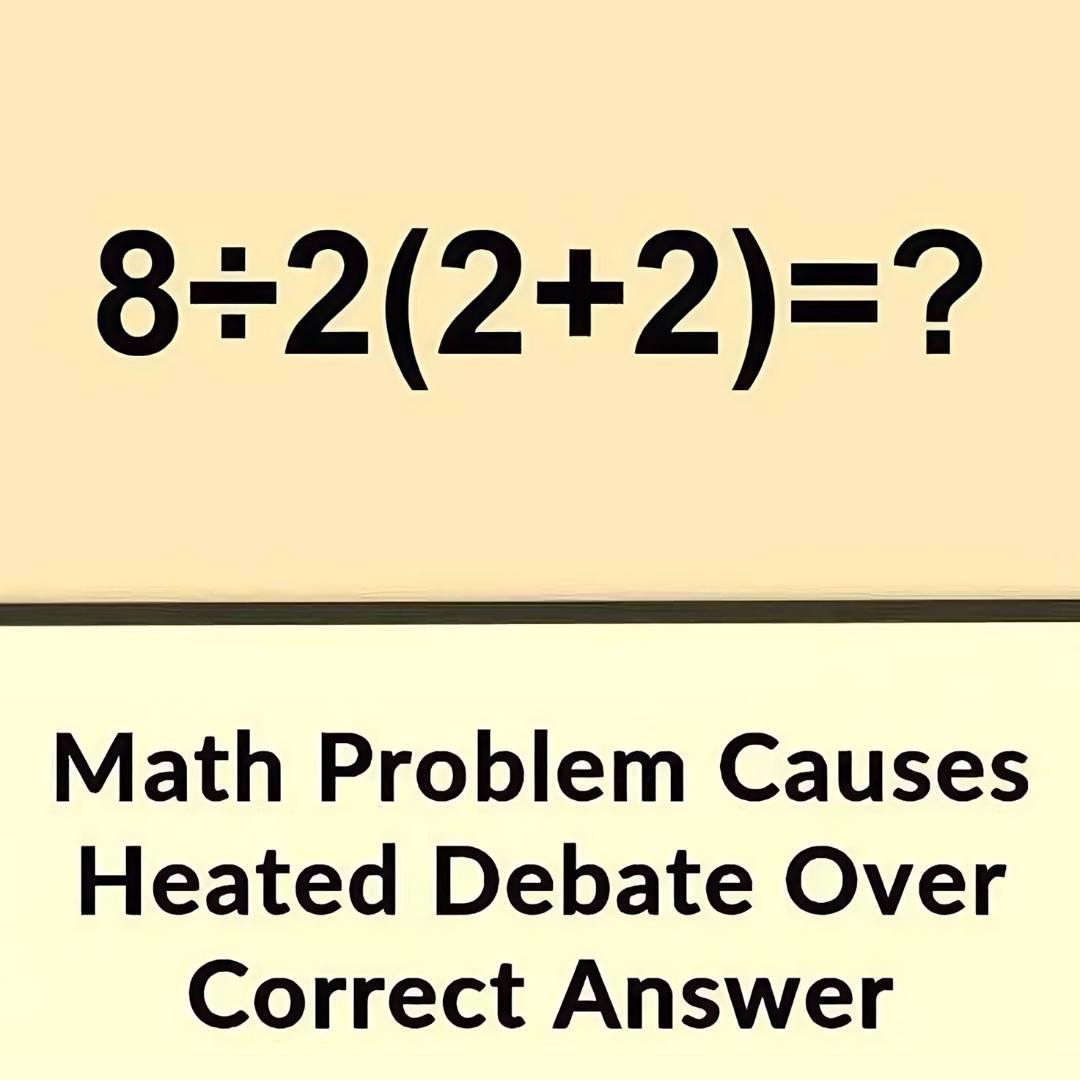In an age of viral debates and trending challenges, one seemingly simple math problem has ignited a firestorm of controversy across the internet. The equation, 8 ÷ 2(2 + 2), looks straightforward at first glance but has sparked a fierce battle of interpretations that continues to divide social media users, educators, and even math professionals. This viral sensation is about more than just numbers—it’s a fascinating case study in how mathematical conventions can shape our understanding of problems.

The Equation That Broke the Internet
The controversy began in 2019 when someone posted the equation 8 ÷ 2(2 + 2) on Twitter, asking users to solve it. Instead of a unanimous answer, the internet erupted into a heated debate between two camps, each adamantly defending their results: 16 and 1. The equation’s viral success didn’t stem from its complexity but from the ambiguity in how it was written, exposing differing interpretations of mathematical rules taught worldwide.
The Root of the Controversy: PEMDAS
At the core of the debate is PEMDAS, the widely taught rule for the order of operations in math. PEMDAS stands for:
- Parentheses
- Exponents
- Multiplication
- Division
- Addition
- Subtraction
According to PEMDAS, operations inside parentheses are solved first, followed by exponents, then multiplication and division from left to right, and finally addition and subtraction from left to right. While PEMDAS provides a clear structure for solving equations, the challenge arises when ambiguous notation blurs the boundaries between steps.
Team 16 vs. Team 1: Two Interpretations
The disagreement over 8 ÷ 2(2 + 2) boils down to how the equation is grouped and interpreted. Here’s how each side arrived at its answer:
Team 16
This group follows PEMDAS strictly:
- Solve the parentheses: 2 + 2 = 4
- Replace the parentheses with their result: 8 ÷ 2(4)
- Treat the equation as 8 ÷ 2 × 4, performing division and multiplication from left to right:
- 8 ÷ 2 = 4
- 4 × 4 = 16
By this method, the answer is 16.
Team 1
This interpretation approaches the problem differently:
- Solve the parentheses: 2 + 2 = 4
- Treat 2(4) as a single term (implied multiplication): 8 ÷ [2(4)]
- Simplify the equation:
- 8 ÷ 8 = 1
Using this grouping, the answer is 1.
- 8 ÷ 8 = 1
Why the Confusion?
The confusion arises from how implied multiplication (e.g., 2(4)) is prioritized. Historically, implied multiplication was treated as having higher precedence than division. However, modern conventions treat multiplication and division equally, solving them from left to right. This shift in rules has led to widespread disagreement over problems like 8 ÷ 2(2 + 2).
Expert Opinions: Ambiguity in Mathematical Notation
Math experts have weighed in on the debate, acknowledging the ambiguity in the equation’s notation. Mike Breen from the American Mathematical Society stated that while 16 aligns with strict PEMDAS rules, the lack of clarity in how the equation is written makes 1 a defensible answer. Breen suggested that rewriting the equation explicitly could resolve the confusion, such as:
- (8 ÷ 2)(2 + 2) to clearly produce 16.
- 8 ÷ [2(2 + 2)] to unambiguously yield 1.
Physics professor Rhett Allain echoed this sentiment, emphasizing that the debate highlights a gap between mathematical notation and interpretation. Professionals typically work with clear formulas, but casual math problems often leave room for multiple “correct” answers depending on context.
Why Did This Problem Go Viral?
The equation captured the internet’s attention for several reasons:
- Nostalgia: Many people enjoyed revisiting high school math concepts like PEMDAS.
- Rivalry: The divide between Team 16 and Team 1 created a competitive dynamic.
- Accessibility: Unlike complex puzzles, this equation was simple enough for anyone to attempt, making it an inclusive challenge.
The debate transcended math, sparking curiosity and conversation about how we communicate ideas, not just in numbers but in life.
The Broader Lesson: Clarity in Communication
The controversy underscores an important lesson: clear communication is essential, especially in mathematics. While the problem might seem trivial, it illustrates how small ambiguities in notation can lead to drastically different interpretations. In real-world applications like engineering or data analysis, such misunderstandings could result in costly errors, highlighting the need for precision in how mathematical expressions are written and taught.
The Legacy of a Viral Math Problem
Years after it first appeared, 8 ÷ 2(2 + 2) continues to spark debates and inspire people to revisit basic math principles. Whether you side with Team 16 or Team 1, the equation serves as a reminder of the complexities and beauty of mathematics. It challenges us to question assumptions, explore interpretations, and appreciate the role of communication in problem-solving.
Conclusion: Math as a Catalyst for Curiosity
The debate over this equation may never fully be resolved, but that’s part of its charm. 8 ÷ 2(2 + 2) has become more than a math problem—it’s a cultural phenomenon that bridges gaps between education, logic, and everyday life. Whether it leaves you frustrated or fascinated, one thing is clear: math has the power to spark curiosity, connection, and endless conversation. So the next time you encounter a puzzling equation, don’t just look for the answer—embrace the journey it takes you on.





